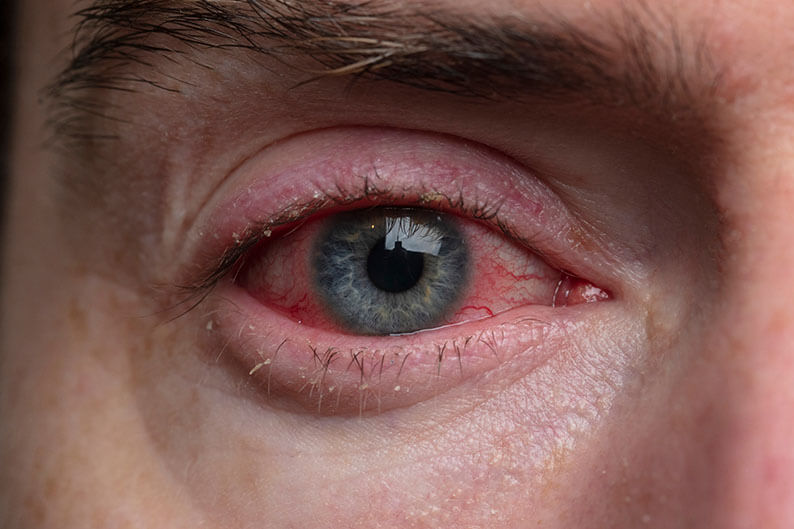Blepharitis
What is Blepharitis?
Blepharitis is a very common, chronic infection of the eyelids, characterized by inflammation of the eyelid margin (the place where the lid and lashes meet). Blepharitis has a variety of causes, including infection and excess oil production. This disorder often recurs, sometimes with months between episodes, and needs repeated treatment. The severity may change each time. The disorder is usually a form of eczema. In some cases, the matter is made worse by bacterial infection.
How Does Blepharitis Develop?
Among the most common causes of blepharitis are:
Excess Oil Produced By the Glands in the Eyelid
Bacterial Infection (often staphylococcal)
There are two main types of blepharitis: staphylococcal and seborrheic. Staphylococcal blepharitis is caused by a germ called Staphylococci, commonly known as “staph.” It often begins in childhood and continues throughout adulthood. This form of the condition results in collar scales on lashes, crusting, and chronic redness at the lid margin. Dilated blood vessels, loss of lashes, styes, and chalazia also occur.
Seborrheic blepharitis is the most common and least severe form of this condition. It is not an infection but is caused by improper function of the oil glands, which causes greasy, waxy scales to accumulate along the eyelid margins. Seborrhea may be a part of an overall skin disorder that affects other areas. Hormones, nutrition, general physical condition, and stress are factors in seborrhea.
Ulcerative blepharitis is a third, less common but more severe type of blepharitis that may be characterized by matted, hard crusts around the eyelashes, which, when removed, leave small sores that may bleed or ooze. There may also be a loss of eyelashes, distortion of the front edges of the eyelids, and chronic tearing. In severe cases, the cornea, the transparent covering of the front of the eyeball, may also become inflamed.
What are the Symptoms?
Some patients with acute or chronic blepharitis may have a bacterial infection of the eyelid margins caused by staph. Typical changes of staph blepharitis are scaly skin flakes along the eyelid margins. These crusts cause the eyelid margins to stick together and can alter the growth of the eyelashes or cause lashes to fall out. When these flakes get into the tear film, a gritty sensation occurs that can lead to red, irritated eyes and light sensitivity.
Common symptoms of Seborrhea blepharitis include blurred vision and redness. Excess oil gland production can lead to roughened eyelids and mucous debris that accumulates during sleep. Sometimes, Seborrhea blepharitis may result in a roughness of the normally smooth tissue that lines the inside of the eyelids, or chalazia, which are nodules on the eyelids (often painless and firm in texture). Acute infection of the eyelids can result in styes. Some patients with this form of blepharitis have dandruff, acne, or other skin conditions such as seborrhea or acne rosacea.
How can Blepharitis be prevented?
Good hygiene is very important for both preventing blepharitis and minimizing the irritation caused by the condition. Any eye irritation, from cosmetics to air pollution, can prolong and intensify the symptoms of blepharitis.
What Treatments are Available?
Treatment is very important. In addition to eliminating the redness and soreness, treatment can prevent potential infection and scarring of the cornea and conjunctiva. A complete eye examination is necessary in order to determine the most effective treatment.
Cleaning
Usually, blepharitis can be controlled by careful, daily cleaning of the eyelashes. This can be accomplished by moistening a clean washcloth with warm tap water. Hold the washcloth against the eyelids until it cools. Re-warm and repeat for 5 to 10 minutes. We recommend using a clock to keep track of the time. After soaking, gently scrub each eyelid for one minute. Use a clean washcloth, moistened with warm water, wrapped around the index finger. Some patients have found that cotton-tipped applicators, like Q-tips, are also useful to remove accumulated material from the eyelashes.
If the process above isn’t sufficient, try another trick: make a mild solution with a few drops of non-irritating baby shampoo and warm water. Dip a washcloth in the solution, and gently massage the eyelid. Being careful to avoid getting shampoo in the eye, scrub back and forth along the eyelashes of all eyelids, then rinse with plain tap water. Once the redness and soreness are under control, this cleaning may be decreased from daily to twice weekly. However, if the symptoms return, daily cleansing must be resumed immediately.
Medication
In some cases, eye drops or ointment will be prescribed to be used along with the daily cleansing regimen. For ointments, use a clean fingertip to rub a small amount into the eyelashes. Be careful to follow recommended dosages; excess medication will cause temporary blurring of vision. And with any medication, there is a small possibility of allergic or other reactions. If you think this is happening, stop the medication and contact your doctor immediately.
For certain types of blepharitis, medications taken by mouth are helpful. Most of these medications are antibiotics; they also improve or alter the oil composition of the eyelid oil glands. When taken properly, they are safe drugs. However, side effects may occur in some individuals, including skin rash, slight nausea, and increased sensitivity to the sun.
Although medication may help control the symptoms of blepharitis, medication alone is not sufficient. Keeping the eyelids clean is essential. If you think you may have blepharitis, your eye doctor can determine the cause and recommend the right combination of treatment specifically for you.






